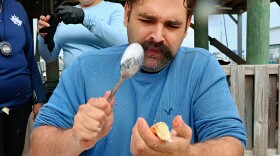Scientists have discovered how a tiny worm-like creature with no arms, legs or wings nonetheless manages to perform stupendous leaps through the air.
The acrobatic feats of these larvae were first noticed by Mike Wise of Roanoke College a few years ago, and now, in the Journal of Experimental Biology, he and some colleagues explain this critter's unusual trick.
Wise studies how plants defend themselves from hungry insects, and one day he was dissecting tumor-like swellings on goldenrod that form around the maggot-like larvae of developing flies.
"The larvae get as big, when they're full grown, as, say, a small grain of rice," says Wise, who adds that the maggot-like creatures are bright orange. "Generally I take the larvae out, and put them in a little dish next to my microscope. And they barely move. They may wiggle around just a little bit."

One day, after he'd spent about an hour removing a dozen or so, he looked down at the dish and they were gone.
"I was wondering what was going on," recalls Wise. "And then I caught out of the corner of my eye a little bit of motion, a little orange larva jumping across my table."
All around him, the larvae were leaping. "I looked on the floor and there had been some that had jumped all the way to the wall," says Wise.
To understand how they were doing this, he brought bouquets of infested goldenrod to the lab of Sheila Patek, a biologist at Duke University who studies small, extremely fast things — like the deadly strike of the mantis shrimp or the snapping bite of trap-jaw ants.
"I know that sounds super quirky," says Patek. "But it turns out that this arena of biology is a very interesting one," because these creatures do stuff that engineers can only dream of.
Her lab filmed Wise's leaping larvae with some of the world's best high-speed cameras.
What they found is that these wormy guys start by curling up into a loop. Lab member Grace Farley found that the creatures have a special patch of hair on their heads that sticks to a patch of hair on their rear ends.
"They're using essentially dry adhesion with microscopic hairs that they touch together between their head and their tail," says Patek.
Then the critters squeeze fluid through their soft bodies to stiffen up the part that's against the ground. They keep doing that until they've generated enough force that it suddenly unsticks the hairs and launches them up into the air.
Sarah Bergbreiter, a mechanical engineer at Carnegie Mellon University, was impressed.
"One of the really cool things about it is that these are soft-bodied jumpers. That means they're squishy and they can jump over 30 body lengths, which is pretty incredible," says Bergbreiter, adding, "It's comparable to fleas which we think of as great jumpers."
She and other researchers are interested in developing robots that are soft instead of rigid and clunky.
"Robots can be far more robust if they have these softer materials as part of them," says Bergbreiter. "They have incredible advantages in that you can step on them and they can still move, but they typically have these very awkward and inefficient gaits."
These soft-bodied creatures, however, jump around by effectively creating a sort of temporary leg.
"The idea that a soft robot could kind of develop this appendage that's useful for the moment and then reconfigure it into something else," she says, "is pretty cool."
Copyright 2023 NPR. To see more, visit https://www.npr.org.








